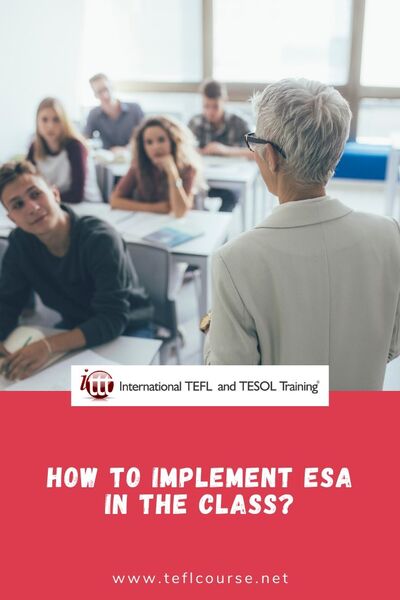How to Implement ESA in The Class?

I felt confused by it when I saw it the first time but now it's unforgettable for me. E represents Engage, S is for study and A means activate. During my study of the TEFL course, I initially thought I would have only learned about ESA in one unit but it wasn't the case. I had a high frequency of interaction with it throughout the TEFL course.
Table of Contents
As teachers, how do we implement ESA in the class?
A clear representation of the study.
A practical approach to the activation phase.
Do you want to teach English abroad? Take a TEFL course today!
This post was written by our TEFL certification graduate Pei dong W. Please note that this blog post might not necessarily represent the beliefs or opinions of ITTT.
As teachers, how do we implement ESA in the class?
The first step is to have a deep understanding of the aim of each part, then the ways we can implement it, following that, we need to figure out some problems may arise from students in the class. Some of which might be common pronunciation issues or second language interference.
Also Read: 7 Fun Reward Systems That Will Keep Your Students More Engaged
The purpose of Engage.
The key point of the engagement aspect is to draw students' attention to the classroom environment and specifically regarding ESL, which is to get them thinking in English. It is commonly referred to as a warm-up. In general, I will let them have a short introduction about themselves. A good ice breaker for the students is to talk about their names, jobs, hobbies, etc. Sometimes starting the conversation that is related to the topic is a great point of penetration to engage students. For example, if we are going to learn about Travel, I will encourage them to ask each other where they have been for their last vacation. My goal in doing so is to help them find something in common through the process of communication.
A clear representation of the study.
I make a summary for the engagement and recap, review, and pre-teach the new vocabulary, phrases, and sentence patterns by photos, body language, and use of realia. I still take traveling as an example here, I might bring a boarding pass into class and have the students discuss language related to the airport. Furthermore, they will have extra exercises to guarantee they understand the target language. Like gap filling, matching, true or false questions, and so on. The interaction with teachers and students is also important. I will elicit them with Wh & H questions, then, they can express their thoughts and opinions about places, relationships, and transportation. After that, everyone has a chance to say a full sentence with new words or grammar in different ways. I can determine if it is grammatically correct after their output. The last step in the study process is to guide them to do the self-correction and praise them for above-average performance.
Also Read: You've finished your TEFL course - Now what?
A practical approach to the activation phase.
In the end, I have to activate the student's English capabilities. It all comes down to how to apply what they've learned to daily life situations, experiences, and exposures. I would like to say it's a brainstorm in this regard. My purpose is to make them feel comfortable, confident, and content when using the target language when they converse with others. What I focus on should have a connection with their life so I will give them some backgrounds. Roleplay is a classic model to let them express their ideas. Let's keep using "Traveling" to explain the way to activate the students. It will start by telling them if they may have ten days off, how would they plan a trip around that. I would give them a piece of paper so that they can write it down. Finally, they need to stand in front of other students and share their travel plans as a travel agent. Students that sit on the seats can ask some questions about it as a client. Everyone votes for the best one and explains their reason. I will walk around them to check if they have any questions and give suggestions.
During the class, I may have time constraints. Students may feel puzzled about the instruction after I tell them. This is a great moment to implement CCQs and ICQs. If it happens, I prefer to show them how to do it rather than keep repeating the instructions. I like to create a fun atmosphere in the classroom. Games go a long way in this regard.
Do you want to teach English abroad? Take a TEFL course today!
Ways to implement ESA in the class are diverse. It depends on the student's level, numbers, and time of the class. A successfully demonstrated ESA approach is visible on students' progress.
Apply now & get certified to teach english abroad!
Speak with an ITTT advisor today to put together your personal plan for teaching English abroad!
Send us an email or call us toll-free at 1-800-490-0531 to speak with an ITTT advisor today.
Related Articles:
- 10 Tips for Teaching Grammar to EFL Students Abroad
- Top 10 Things To Know When Moving Abroad To Teach English
- 4 Top Tips For Getting Your TEFL Certificate on the Road
- What TEFL course is most useful?
- What's Stopping You from Teaching English Abroad?
- The Best Countries to Teach ESL When You're 50+




